Cover image: Fork-tailed Drongo by Desire Darling – Komdomo, Eastern Cape – BirdPix No. 28186
Drongos belong to the Family: DICRURIDAE. All drongos are placed in a single genus, Dicrurus with 28 known species. Drongos are mostly black or dark grey, short-legged birds, with an upright stance when perched. They have forked tails and some have elaborate tail decorations. They are widely distributed in the old world tropics from Africa and tropical Asia, to Australasia and the Solomon Islands.
Identification
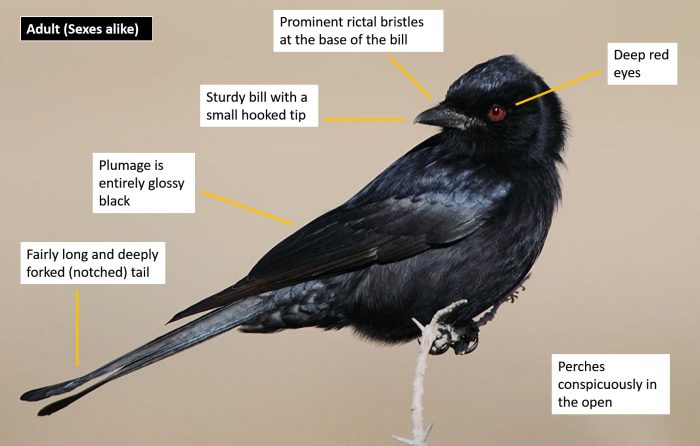
Kgalagadi Transfrontier Park, Northern Cape
Photo by Trevor Hardaker
The Fork-tailed Drongo is a bold and conspicuous species. It is entirely black overall with a glossy blue or purplish sheen. It has a longish, deeply forked tail. During moult the tail often has a double fork until the feathers have fully grown out. The eyes are dark red and are an important identification feature. The legs and feet are black. The bill is fairly short and sturdy with a small hooked tip. The Fork-tailed Drongo has prominent rictal bristles at the base of the bill. In flight the wings appear pale to almost translucent. The sexes are very similar but females have less deeply forked tails.

Swartvlei Mouth, Western Cape
Photo by David Kennedy
Immatures resemble the adults but are dusky grey below with dense pale grey speckles.
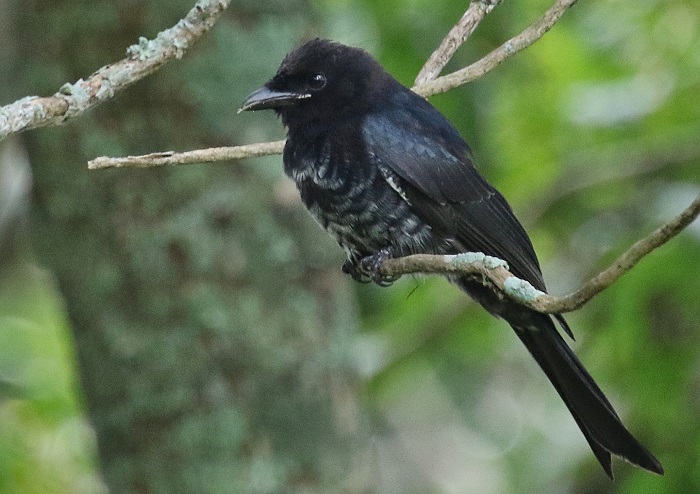
Shellybeach, KwaZulu-Natal
Photo by Lia Steen
The Fork-tailed Drongo is most likely to be mistaken for the Square-tailed Drongo (Dicrurus ludwigii) and the Southern Black Flycatcher (Melaenornis pammelaina). The Square-tailed Drongo is smaller with a square or slightly notched (not forked) tail. The two species also differ in their choice of habitat with the Square-tailed Drongo inhabiting forests rather than open woodland, ensuring they are largely ecologically separated. However, they can co-occur in certain areas, such as north-eastern KwaZulu-Natal. The Southern Black Flycatcher is also similar but is smaller with a more slender build. It also has a less robust bill that lacks the hooked tip, and blackish (not dark red) eyes.
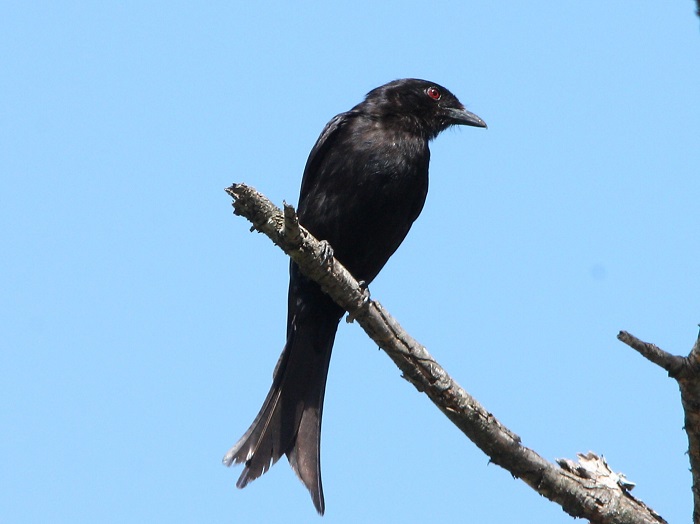
Zaagkuilsdrift, Limpopo
Photo by Mike Nyenes
Status and Distribution
The Fork-tailed Drongo occurs throughout most of sub-Saharan Africa, except for very arid and otherwise treeless regions. In southern Africa it mostly avoids highveld grassland areas, the central and western Karoo, Namaqualand, the west coast lowlands of South Africa and the Namib desert of Namibia.
The Fork-tailed Drongo is a common resident, with some short-distance local movements in winter related to food availability.
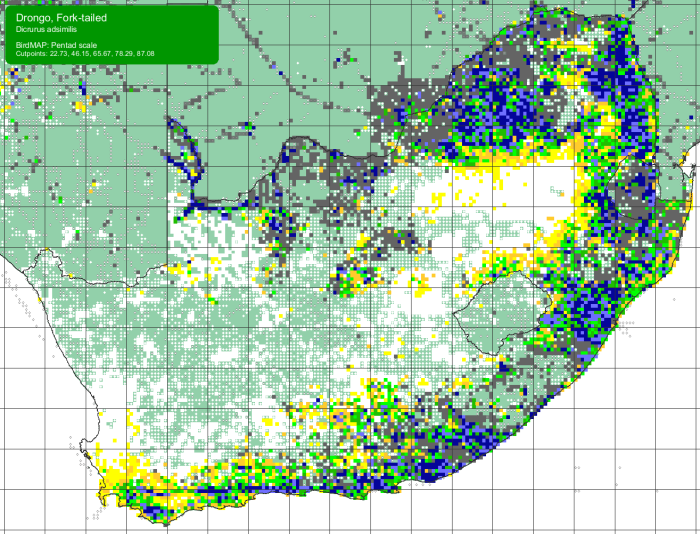
Details for map interpretation can be found here.
The Fork-tailed Drongo has expanded its range slightly further into the south-western Cape in recent decades and is not considered threatened.
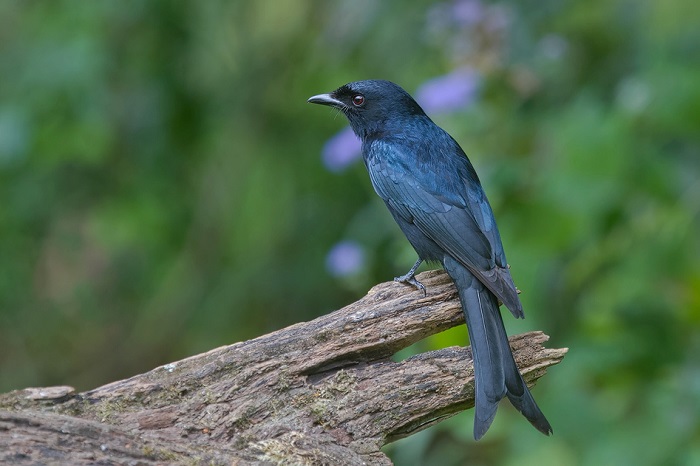
Wilderness, Western Cape
Photo by Desire Darling
Habitat
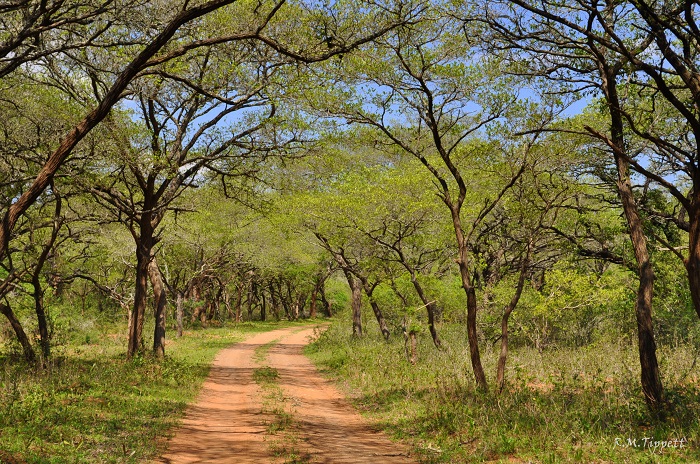
Ndumo Game Reserve, KwaZulu-Natal
Photo by Ryan Tippett
The Fork-tailed Drongo is primarily a woodland species. It inhabits a range of woodland types, including denser, moist woodland and open arid savanna, including the Kalahari. The Fork-tailed Drongo is also found in riverine woodland, exotic plantations, gardens, parks and farmyards. Its presence in grassland is dependant on the availability of perches like copses of alien trees or fence posts and telephone poles. It regularly occurs along forest edges but avoids the forest interior.
Behaviour
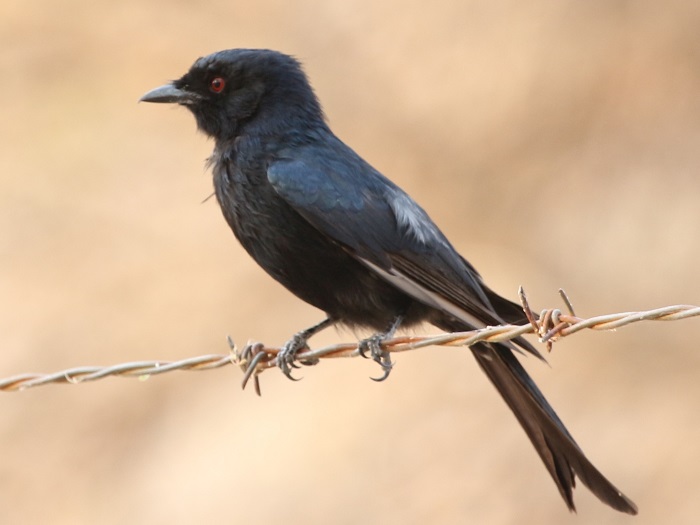
Tsanakona, Botswana
Photo by Gert Myburgh
The Fork-tailed Drongo is conspicuous owing to its bold and aggressive behaviour and harsh, scolding calls. It is usually found solitarily or in pairs, but sometimes also in larger groups where food is abundant such as flowering aloes or termile alate emergences. Typically perches in the open on a branch or post. As it is an aggressive species, the Fork-tailed Drongo will readily mob snakes and larger birds like raptors, owls, hornbills or crows, and also small mammals like the Slender Mongoose. It is particularly aggressive at the nest, and will even attack humans that get too close.
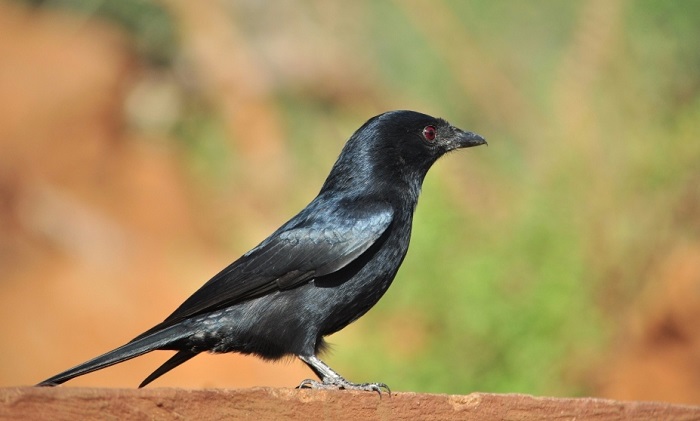
Zimanga Game Reserve, KwaZulu-Natal
Photo by Ryan Tippett
Bathes by plunge-diving from the air or perch and will also bathe in the rain by spreading its wings and tail, and raising the back feathers. The flight is buoyant, undulating and agile with a swift turn of speed when needed, allowing the Fork-tailed Drongo to evade fast-flying raptors such as goshawks.
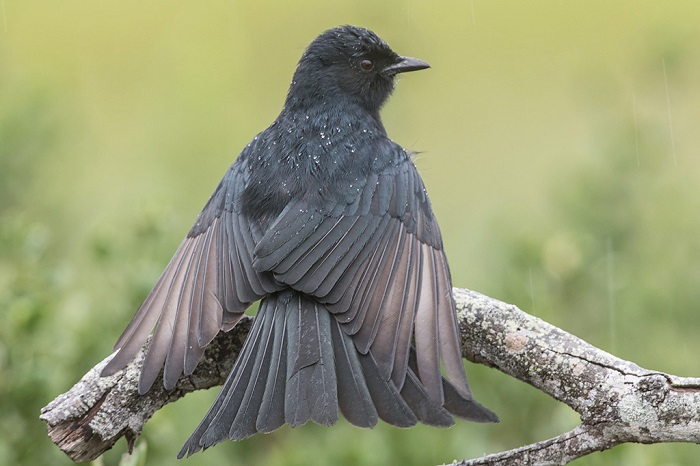
St. Francis Bay Air Field, Eastern Cape
Photo by Gregg Darling
It forages by hawking prey aerially from a perch but also catches prey on the ground. The Fork-tailed Drongo is primarily an insectivore but consumes a wide variety of food. Most insect prey is captured in flight, including dragonflies, butterflies, moths, termite alates and flies. It seems to be especially fond of stinging insects like bees and wasps. The stiff rictal bristles around the base of the bill are thought to help protect its face and eyes from stings and are also likely to provide a sensory function.
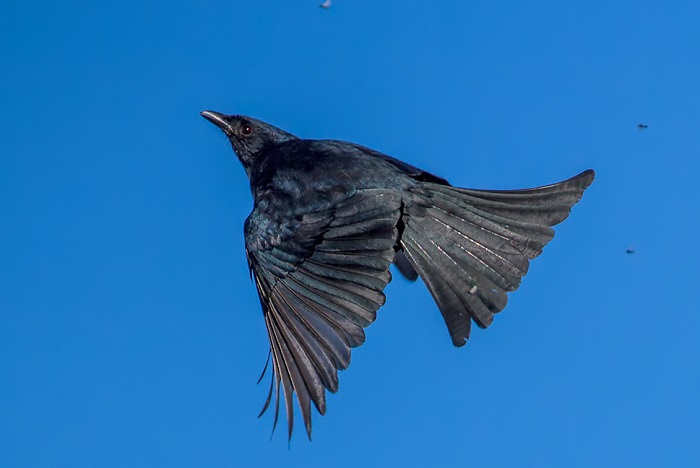
St. Francis Bay Air Field, Eastern Cape
Photo by Gregg Darling
The Fork-tailed Drongo will also snatch prey like caterpillars and spiders from the surface of vegetation. It consumes nestlings and small adult birds like mannikins and canaries and has even been recorded to catch small fish from the the water surface. Larger prey is held down with one foot and eaten. The Fork-tailed Drongo also eats ticks which they remove from cattle and game animals, and they readily consume nectar, especially from large Aloe species.

Graaff- Reinet district, Eastern Cape
Photo by Alan Collett
The Fork-tailed Drongo is an intelligent and adaptable species with many interesting behavioural traits and interactions…
- It regularly joins mixed-species foraging flocks where it is often kleptoparasitic, stealing food from other birds. If it spots another bird that had found food it may sound a ‘false alarm’ call, causing that bird to drop the morsel and flee towards cover. The drongo then swoops in to grab the dropped food.
- Similarly, in the Kalahari, the Fork-tailed Drongo, perches above foraging Meerkats/Suricates (Suricata suricatta) and, when a meerkat has found food, swoops down, giving an alarm call. The meerkats then usually scatter, leaving the food, which the drongo then takes.
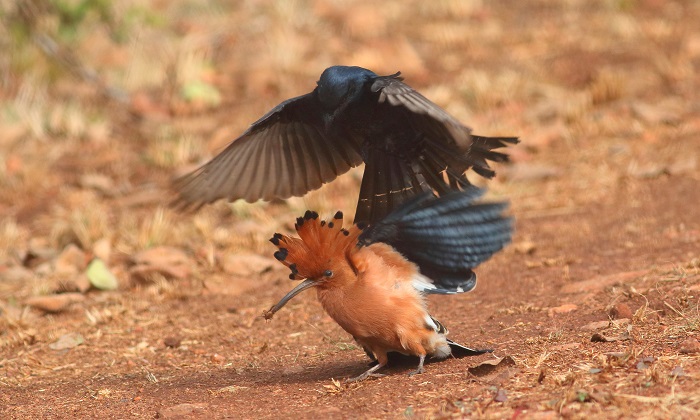
Near Hartebeespoort, North West
Photo by Andrew Keys
- It forages at lights at dusk and dawn, where it feeds on flying insects attracted by the light. There is even a record of feeding in floodlights at a game lodge during the night.
- The Fork-tailed Drongo is an accomplished voice-mimic and often imitates the calls of predatory birds like the Pearl-spotted Owlet (Glaucidium perlatum) or African Goshawk (Accipiter tachiro). This is thought to deter other birds that may compete with the drongo from entering its territory.
- It perches on, or close to beehives, hawking bees that leave or return to the hive.
- It associates with walking humans and and perches on large mammals to catch flushed prey or to glean ticks.
- It is attracted to veld fires, where it forages downwind from the flames in an attempt to catch fleeing insects.

Hwange National Park, Zimbabwe
Photo by Derek Solomon
The Fork-tailed Drongo is recorded to breed virtually throughout the year in southern Africa, with a peak during late spring and summer (September to November). It is a monogamous, solitary nester and is strongly territorial.
The nest is a tightly woven, shallow cup. The floor and sides of the nest are thin and woven out of pliable plant stems, rootlets, tendrils and twigs. The nest is neatly bound with spider web and is usually placed in the horizontal fork of an outermost tree branch. The nest is firmly secured to the branch with additional spider web. Both sexes help to construct the nest which takes around four days to complete.

Shellybeach, KwaZulu-Natal
Photo by Lia Steen
The clutch size varies from two to five eggs and the egg colouration is highly variable. The base colour may be white, pink or cream, and the eggs may be plain or speckled and blotched with with dark pink, reddish brown or brown markings.
Incubation starts once the full clutch has been laid. The incubation period usually lasts for 16 days and is performed by both sexes. The newly hatched young are altricial and are fed and brooded by both parents. The nestling period lasts for 17 to 18 days. The Fork-tailed Drongo is usually single brooded but pairs may lay a replacement clutch after an early failure.

Thabazimbi district, Limpopo
Photo by Neels Putter
The Fork-tailed Drongo is the only known host of the African Cuckoo (Cuculus gularis) and is occasionally also parasitised by the Jacobin Cuckoo (Clamator jacobinus).
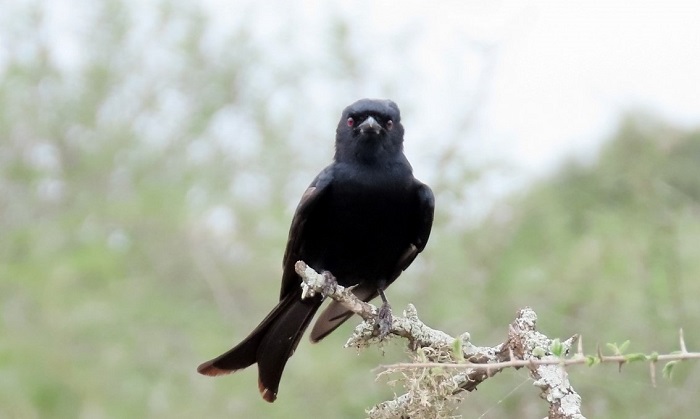
Mkhuze Game Reserve, KwaZulu-Natal
Photo by Colin Summersgill
Further Resources
Species text in the first Southern African Bird Atlas Project (SABAP1), 1997.
The use of photographs by Alan Collett, Andrew Keys, Colin Summersgill, David Kennedy, Derek Solomon, Desire Darling, Gert Myburgh, Gregg Darling, Lia Steen, Mike Nyenes, Neels Putter and Trevor Hardaker is acknowledged.
Virtual Museum (BirdPix > Search VM > By Scientific or Common Name).
Other common names: Mikstertbyvanger (Afrikaans); iNtengu (Zulu); Intengu (Xhosa); Kuamosi (Tswana); Drongo brillant (French); Fluweeldrongo (Dutch); Trauerdrongo, Gabelschwanzdrongo (German); Drongo-de-cauda-forcada (Portuguese).
List of bird species in this format is available here.
Recommended citation format: Tippett RM 2024. Fork-tailed Drongo Dicrurus adsimilis. Biodiversity and Development Institute. Available online at https://thebdi.org/2024/07/15/fork-tailed-drongo-dicrurus-adsimilis/
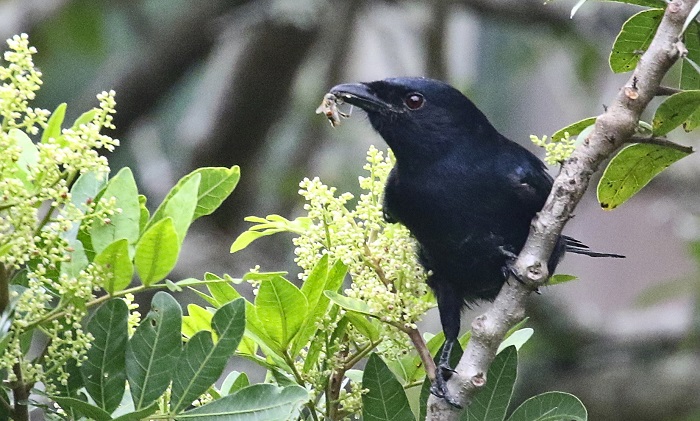
Shellybeach, KwaZulu-Natal
Photo by Lia Steen

